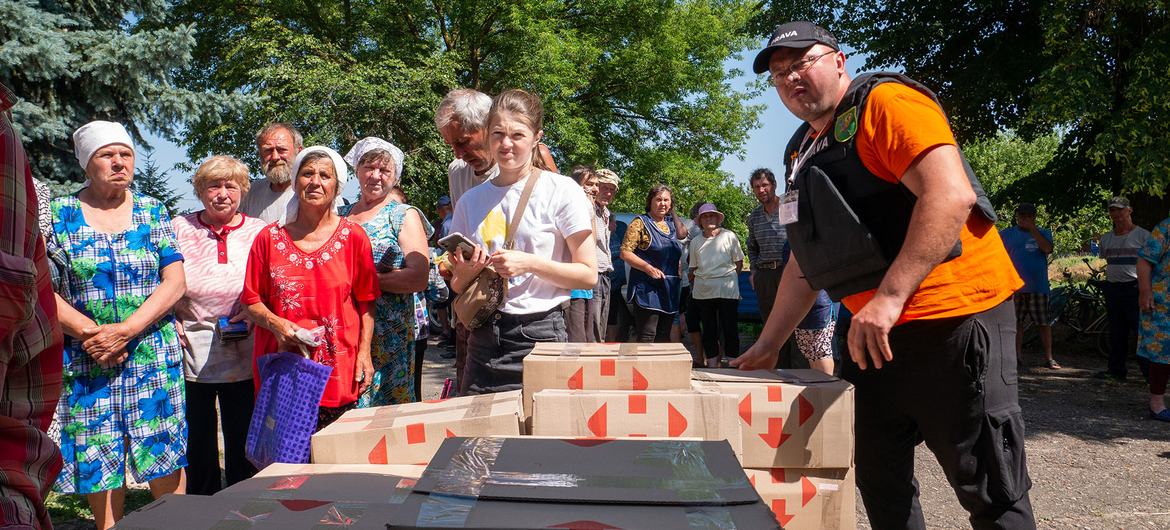
Across Ukraine, the scale of needs caused by Russia’s invasion is still massive and human rights concerns persist, UN humanitarians said in an update on Thursday, as they repeated calls for access to the country’s Black Sea ports to export vitally needed cereals.
Speaking from Kyiv, Humanitarian Coordinator for Ukraine, Osnat Lubrani, described the heartbreak she felt after seeing “this destruction, this suffering”, in Mariupol, Kharkiv, Kyiv, Bucha, Irpin and beyond.
“I’ve been traveling around Ukraine and my heart breaks when I see this destruction, this suffering,” @OsnatLubrani speaking about the thousands of schools, hospitals and homes destroyed, and thousands of civilians killed or injured in #Ukraine. pic.twitter.com/WIYV2sdkJN— OCHA Ukraine (@OCHA_Ukraine) June 30, 2022
The UN and hundreds of national partners and volunteers have done their utmost to help those most in need, but much more could be done by the Russian and Ukrainian authorities to protect civilians, she insisted.
Water, food, health and shelter lacking
“Almost 16 million people in Ukraine today need humanitarian assistance; water, food, health services, a roof over their heads, protection. These are conservative numbers that the United Nations is in the process of revising now.”
Outside the war-ravaged country, amid growing alarm over global food insecurity in part caused by the lack of safe access to Ukrainian ports and the cereal silos they house, the UN World Food Programme (WFP) repeated its calls to reach them.
Export efforts falling short
“Without the Black Sea ports, we cannot get anywhere close to the kind of export levels that Ukraine urgently needs,” said Kate Newton, WFP Ukraine Deputy Emergency Coordinator.
“However, we’re doing everything we can, which means by road, by rail and now by river, to try to get close to the maximum output. And at the moment, we think it’s about one million metric tonnes a month and maybe we can push up to two million, but we urgently need access to the Black Sea.”
Since the Russian invasion on 24 February, the UN has monitored the number of civilians killed and injured across Ukraine by the conflict. This process is exhaustive, meaning that the true number of victims is almost certainly far higher.
Thousands of civilian targets
“The number we have of almost 5,000 civilians killed and more than 5,000 injured is just a fraction of the frightening reality,” said Ms. Lubrani, who also highlighted the widespread targeting of civilian infrastructure during exchanges of shelling.
“I cannot speak of precise numbers of the hospitals that were damaged and the schools and the homes, but we know that it is in the thousands, we simply cannot yet verify the exact numbers.”
More than 300 organisations are working on the humanitarian response in Ukraine, almost 200 of them national non-governmental organisations involving Ukrainians “who are the first-responders…they are truly supporting one another”, Ms. Lubrani said.
Aid limits
Since 24 February, the UN and humanitarian partners have provided lifesaving assistance to nearly nine million people in every single region of Ukraine, the UN top aid official there continued, adding that nearly two million had received cash assistance to “make their own choices to meet their basic needs”.
Despite these successes, aid access is still too dangerous in many places.
“We could not deliver relief supplies or access Kherson,” Ms. Lubrani said. We could not deliver relief supplies or access Mariupol. We could not support any sort of assistance, have not even managed to have the parties to agree on safe passages to evacuate people from Sievierodonetsk, so they could move in the direction of their choice.”
© UNICEF/Juan Haro
A family who fled conflict in Mariupol arrives at Liviv train station in Ukraine.
The UN Humanitarian Coordinator for Ukraine insisted that this scenario “is not new for the mother of a four-month-old baby that I met when supporting the evacuations from Mariupol and Azovstal plant there, who told me how she survived for months without seeing the sunlight, how she struggled to feed herself, and how she and others had to survive without enough clean water to drink.”
And Ms. Lubrani continued that it was also “not new for people in almost the entire Luhanska oblast, not only Sievierodonetsk and Lysychansk, where we have seen the images of destruction caused by the clashes between the parties to this horrendous conflict”.
‘Filtration’ concerns in Mariupol
Asked about the situation in the port city of Mariupol, Head of the Human Rights Monitoring Mission in Ukraine, Matilda Bogner, said that the UN was continuing to try to secure access from the Russian forces there.
There are also ongoing concerns about the so-called filtration process of people wishing to leave the devastated city.
“We do understand that if people do not fully pass that filtration process, they can then be detained and held, sometimes in areas in Donetsk and we do fear for their safety,” Ms. Bogner said. “We have documented in the past that people held in detention places in the areas controlled by armed forces – Russian-affiliated armed forces in the east – have been subjected to torture and ill-treatment and we are very concerned that this may be continuing.”
News source: https://news.un.org/en/story/2022/06/1121702